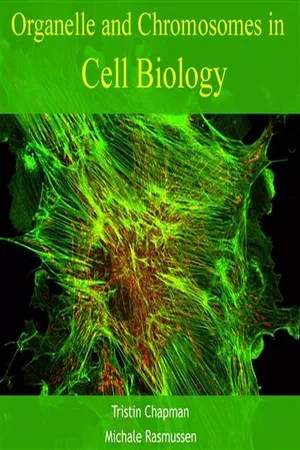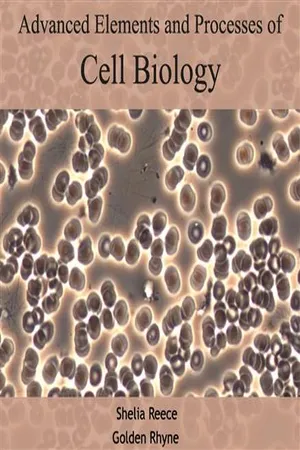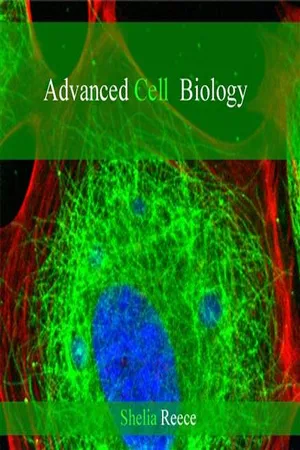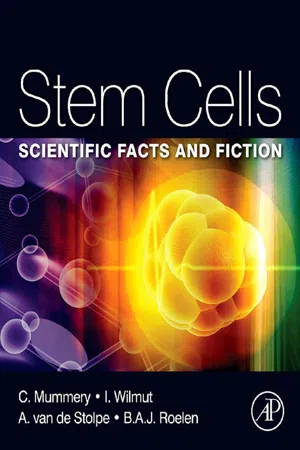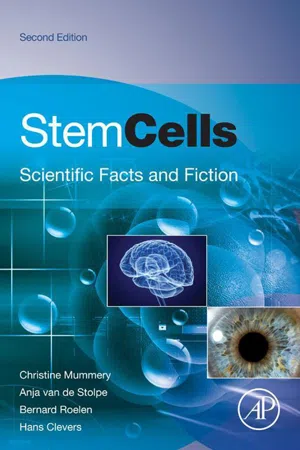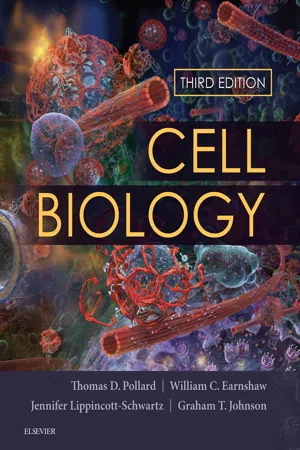Biological Sciences
Cell Nucleus
The cell nucleus is a membrane-bound organelle found in eukaryotic cells, containing the genetic material in the form of DNA. It serves as the control center of the cell, regulating gene expression and coordinating cellular activities. The nucleus is essential for cell division, growth, and reproduction, playing a crucial role in maintaining the integrity and function of the cell.
Written by Perlego with AI-assistance
Related key terms
1 of 5
12 Key excerpts on "Cell Nucleus"
- No longer available |Learn more
- (Author)
- 2014(Publication Date)
- Academic Studio(Publisher)
________________________ WORLD TECHNOLOGIES ________________________ Chapter 7 Cell Nucleus HeLa cells stained for DNA with the Blue Hoechst dye. The central and rightmost cell are in interphase, thus their entire nuclei are labeled. On the left, a cell is going through mitosis and its DNA has condensed ready for division. ________________________ WORLD TECHNOLOGIES ________________________ Schematic of typical animal cell, showing subcellular components. Organelles: (1) nucleolus (2) nucleus (3) ribosome (4) vesicle (5) rough endoplasmic reticulum (ER) (6) Golgi apparatus (7) Cytoskeleton (8) smooth ER (9) mitochondria (10) vacuole (11) cytoplasm (12) lysosome (13) centrioles In cell biology, the nucleus (pl. nuclei ; from Latin nucleus or nuculeus , meaning kernel) is a membrane-enclosed organelle found in eukaryotic cells. It contains most of the cell's genetic material, organized as multiple long linear DNA molecules in complex with a large variety of proteins, such as histones, to form chromosomes. The genes within these chromosomes are the cell's nuclear genome. The function of the nucleus is to maintain the integrity of these genes and to control the activities of the cell by regulating gene expression — the nucleus is, therefore, the control center of the cell. The main structures making up the nucleus are the nuclear envelope, a double membrane that encloses the entire organelle and separates its contents from the cellular cytoplasm, and the nuclear lamina, a meshwork within the nucleus that adds mechanical support, much like the cytoskeleton, which supports the cell as a whole. Because the nuclear membrane is impermeable to most molecules, nuclear pores are required to allow movement of molecules across the envelope. These pores cross both of the membranes, providing a channel that allows free movement of small molecules and ions. - No longer available |Learn more
- (Author)
- 2014(Publication Date)
- College Publishing House(Publisher)
________________________ WORLD TECHNOLOGIES ________________________ Chapter 6 Cell Nucleus HeLa cells stained for DNA with the Blue Hoechst dye. The central and rightmost cell are in interphase, thus teir entire nuclei are labeled. On the left a cell is going through mitosis and its DNA has condensed ready for division. ________________________ WORLD TECHNOLOGIES ________________________ Schematic of typical animal cell, showing subcellular components. Organelles: (1) nucleolus (2) nucleus (3) ribosome (4) vesicle (5) rough endoplasmic reticulum (ER) (6) Golgi apparatus (7) Cytoskeleton (8) smooth ER (9) mitochondria (10) vacuole (11) cytoplasm (12) lysosome (13) centrioles In cell biology, the nucleus (pl. nuclei ; from Latin nucleus or nuculeus , meaning kernel) is a membrane enclosed organelle found in eukaryotic cells. It contains most of the cell's genetic material, organized as multiple long linear DNA molecules in complex with a large variety of proteins, such as histones, to form chromosomes. The genes within these chromosomes are the cell's nuclear genome. The function of the nucleus is to maintain the integrity of these genes and to control the activities of the cell by regulating gene expression — the nucleus is therefore the control center of the cell. The main structures making up the nucleus are the nuclear envelope, a double membrane that encloses the entire organelle and separates its contents from the cellular cytoplasm, and the nuclear lamina, a meshwork within the nucleus that adds mechanical support, much like the cytoskeleton supports the cell as a whole. Because the nuclear membrane is impermeable to most molecules, nuclear pores are required to allow movement of molecules across the envelope. These pores cross both of the membranes, providing a channel that allows free movement of small molecules and ions. The movement of larger molecules such as proteins is carefully controlled, and requires active transport regulated by carrier proteins. - No longer available |Learn more
- (Author)
- 2014(Publication Date)
- Research World(Publisher)
________________________ WORLD TECHNOLOGIES ________________________ Chapter- 6 Cell Nucleus HeLa cells stained for DNA with the Blue Hoechst dye. The central and rightmost cell are in interphase, thus teir entire nuclei are labeled. On the left a cell is going through mitosis and its DNA has condensed ready for division. ________________________ WORLD TECHNOLOGIES ________________________ Schematic of typical animal cell, showing subcellular components. Organelles: (1) nucleolus (2) nucleus (3) ribosome (4) vesicle (5) rough endoplasmic reticulum (ER) (6) Golgi apparatus (7) Cytoskeleton (8) smooth ER (9) mitochondria (10) vacuole (11) cytoplasm (12) lysosome (13) centrioles In cell biology, the nucleus (pl. nuclei ; from Latin nucleus or nuculeus , meaning kernel) is a membrane enclosed organelle found in eukaryotic cells. It contains most of the cell's genetic material, organized as multiple long linear DNA molecules in complex with a large variety of proteins, such as histones, to form chromosomes. The genes within these chromosomes are the cell's nuclear genome. The function of the nucleus is to maintain the integrity of these genes and to control the activities of the cell by regulating gene expression — the nucleus is therefore the control center of the cell. The main structures making up the nucleus are the nuclear envelope, a double membrane that encloses the entire organelle and separates its contents from the cellular cytoplasm, and the nuclear lamina, a meshwork within the nucleus that adds mechanical support, much like the cytoskeleton supports the cell as a whole. Because the nuclear membrane is impermeable to most molecules, nuclear pores are required to allow movement of molecules across the envelope. These pores cross both of the membranes, providing a channel that allows free movement of small molecules and ions. The movement of larger molecules such as proteins is carefully controlled, and requires active transport regulated by carrier proteins. - No longer available |Learn more
- (Author)
- 2014(Publication Date)
- Research World(Publisher)
________________________ WORLD TECHNOLOGIES ________________________ Chapter- 2 Cell Nucleus HeLa cells stained for DNA with the Blue Hoechst dye. The central and rightmost cell are in interphase, thus teir entire nuclei are labeled. On the left a cell is going through mitosis and its DNA has condensed ready for division. ________________________ WORLD TECHNOLOGIES ________________________ Schematic of typical animal cell, showing subcellular components. Organelles: (1) nucleolus (2) nucleus (3) ribosome (4) vesicle (5) rough endoplasmic reticulum (ER) (6) Golgi apparatus (7) Cytoskeleton (8) smooth ER (9) mitochondria (10) vacuole (11) cytoplasm (12) lysosome (13) centrioles In cell biology, the nucleus (pl. nuclei ; from Latin nucleus or nuculeus , meaning kernel) is a membrane enclosed organelle found in eukaryotic cells. It contains most of the cell's genetic material, organized as multiple long linear DNA molecules in complex with a large variety of proteins, such as histones, to form chromosomes. The genes within these chromosomes are the cell's nuclear genome. The function of the nucleus is to maintain the integrity of these genes and to control the activities of the cell by regulating gene expression — the nucleus is therefore the control center of the cell. The main structures making up the nucleus are the nuclear envelope, a double membrane that encloses the entire organelle and separates its contents from the cellular cytoplasm, and the nuclear lamina, a meshwork within the nucleus that adds mechanical support, much like the cytoskeleton supports the cell as a whole. Because the nuclear membrane is impermeable to most molecules, nuclear pores are required to allow movement of molecules across the envelope. These pores cross both of the membranes, providing a channel that allows free movement of small molecules and ions. The movement of larger molecules such as proteins is carefully controlled, and requires active transport regulated by carrier proteins. - eBook - ePub
- William V. Dashek, Gurbachan S. Miglani, William V. Dashek, Gurbachan S. Miglani(Authors)
- 2016(Publication Date)
- Wiley(Publisher)
CHAPTER 8 Nucleus Yogesh Vikal and Dasmeet Kaur School of Agricultural Biotechnology, Punjab Agricultural University, Ludhiana, India Cell nuclei, the most prominent compartment of eukaryotic cells, came first into view around 1830, when Robert Brown described areola within plant cells, which he called nuclei. Descriptions of nuclei in cells of different origin, of nucleoli, and of other subnuclear structures like Cajal bodies (CBs) followed; soon, nuclei were recognized as the structure containing the genetic material. The shape of the nucleus may be related to that of the cells or may be completely irregular. In spheroidal, cuboidal, or polyhedral cells, the nucleus is generally a spheroid. In cylindrical, prismatic, or fusiform cells, it tends to be an ellipsoid. The nucleus occupies about 10% of a eukaryotic cell’s volume. In general, each somatic nucleus has a specific size that depends partly on its DNA content and mainly on its protein content, and so its size is related to functional activity during the period of nondivision. Most of the cells are mononucleate, but binucleate cells (some liver and cartilage cells) and polynucleate cells also exist. In the syncytia, which are large protoplasmic masses not divided into cellular territories, the nuclei may be extremely numerous. The same is the case with striated muscle fibers and certain algae, which may contain several hundred nuclei. The contents of the nucleus are present as a viscous, amorphous mass of material enclosed by a complex nuclear envelope (NE) that forms a boundary between the nucleus and cytoplasm and perforated at intervals by the nuclear pores (Figure 8.1). The nucleoplasm or nuclear sap (the fluid substance in which the solutes of the nucleus are dissolved) in a typical interphase cell contains the uncondensed chromatin and the parts of the chromosomes that remain condensed (chromocenters) - eBook - PDF
- Bert O'Malley, Lutz Birnbaumer, Bert W. O'Malley(Authors)
- 2012(Publication Date)
- Academic Press(Publisher)
That structure plays an important role in the feedback interactions of the nucleus with the whole array of stimuli to which the cell is exposed (Fig. 2). In this sense, the nucleus is part of an integrated system by which cells of various organs respond to extracellular and intracellular stimuli (Fig. 2). These stimuli interact with the nuclear informational system to produce specific products (Table I) that permit response of the cytoplasm to the environment and its functional demands. The charm of the Cell Nucleus rests in the remarkable variety of its potential products which alter cellular function so remarkably from tissue to tissue and organ to organ. A. The Role of the Cell Nucleus The nucleus is the major repository of genetic information, chromatin, which contains DNA and its associated proteins. Very small amounts of DNA are in the mitochondria, and if there is a significant amount of DNA in the cell membrane or the endoplasmic reticulum, it is at such a low level that, thus far, reports of its presence have not been uniformly reproducible. The genetic information of the Cell Nucleus becomes operational in the form of polysomes which contain messenger RNA (template RNA), ribosomes, and associated biosynthetic elements (Fig. 3). A major question in cell and molecular biology is what is the nature of the control systems that regulate the genome. Since the DNA is the same in virtually all cells of an individual (red blood cells and haploid cells excepted), it remains totipotent throughout the life of the cell. The substances that govern the gene readouts must be derived from the cyto-plasm or external cellular milieu directly or by interaction with appropriate receptor or carrier molecules that interact with gene loci. The mechanisms of transport and function of these substances is in Sections I,Β and II,B. - eBook - ePub
Stem Cells
Scientific Facts and Fiction
- Christine L. Mummery, Anja van de Stolpe, Bernard Roelen, Hans Clevers, Christine Mummery(Authors)
- 2010(Publication Date)
- Academic Press(Publisher)
Chapter 1 The Biology of the Cell OutlineOrganisms are Composed of Cells DNA, Genes and Chromosomes How is the Amount of mRNA Regulated? Transcription Factors Epigenetic Regulation RNA Interference From mRNA to a Functional Protein From DNA and Proteins to a Cell with a Function … DNA Differences Between Genomes: Mutation or Variation? Diseases Due to Variations and Genome Mutations Dominant or Recessive? DNA Outside the Nucleus: Bacterial Remains Cell Lines and Cell CultureThis book is about stem cells. Stem cells and their applications in clinical medicine, biotechnology and drug development for pharmaceutical companies, involve many facets of biology; from genetics and biochemistry to synthetic scaffolds and three-dimensional architecture for tissue engineering. For this reason the most important molecular and cell biological principles needed to understand stem cells will be introduced to the reader in this chapter.Organisms are Composed of Cells
Humans and animals, as well as plants and trees, contain many different functional organs and tissues. These, in turn, are composed of a large variety of cells. Cells are therefore the basic building blocks which make up the organism. All animal cells have a similar structure: an outer layer called the plasma membrane, made up of a double layer of lipid molecules, and an inner fluid known as cytoplasm. The cytoplasm contains a variety of small structures called organelles, each of which has a specific and essential function within the cell. Most cell organelles are themselves separated from the cytoplasm by their own membranes. The form of the cell is determined and supported by the cytoskeleton, a flexible scaffolding composed of polymers of protein molecules which form a network that shapes the cell and allows it to move and “walk”. Inside the cell countless proteins – sometimes in cooperation with RNA molecules – facilitate the chemical and physical reactions and transport of other molecules required to carry out specific cellular functions. - eBook - ePub
Physics And Biology: From Molecules To Life
From Molecules to Life
- Jean Franᅢᄃois Allemand, Pierre Desbiolles(Authors)
- 2014(Publication Date)
- WSPC(Publisher)
cella, which means empty space. It was used for the first time in 1665 by Robert Hooke, the first scientist to observe the plant cell using a rudimentary microscope. However, we have to wait for the middle of the 19th century to assert that all living being are constituted by cells.Each cell is a defined entity. It is isolated from the other cells by a cell membrane, which sometimes is rigid like in plants or in bacteria, in which we talk about a cell wall. Inside the cells there are a lot of chemicals and subcellular structures which make possible cell functions.The region where genetic material is located is delimited by a membrane in organisms called Eukaryotes (like animals). This region is called the nucleus and its membrane, the nuclear envelope. In simpler organisms, such as Prokaryotes (e.g. bacteria), there is no nuclear envelope and the region where the genetic material is located is called nucleoid. The enviroment outside the nucleus or the nucleoid is called the cytoplasm.The cytoplasm contains all the machineries necessary for cell function (Fig. 1.1 ).The cytoplasm contains all of the chemicals located inside the internal part of the cell membrane. This is the main functional region of the cell, the location where most of the cell functions take place. In Eukaryotes it is constituted by three main elements: cytosol, organelles and inclusions, which are now discussed.— Cytosol is a viscous liquid in which the other elements constituting cytoplasm are suspended. It is mainly constituted of water, and it contains soluble proteins, salts, and several other solutes.— The inclusions are not functional elements but chemicals which can be present or not, depending on the cell type (like for example glycogen, pigments, metals, etc.)— The organelles are the cell’s metabolic apparatus. Depending on the presence or absence of internal organelles, like the nucleus, we classify the living organism in two categories: the Prokaryotes (Eubacteria and Archaea) and the Eukaryotes (Plants, Fungi, Animals and the rest of Eukaryotes called Protists). - eBook - PDF
- Khushboo Chaudhary, Pankaj Kumar Saraswat(Authors)
- 2023(Publication Date)
- Delve Publishing(Publisher)
Controls what enters/leaves the nucleus. Things only go in or out by passing through. Protein channels, which are selective. Encloses are all the chromosomes chromatin = all the chromosomes, which are long strands of the molecule DNA. DNA regulates all cell activities, yet never leaves the nucleus. Basic Biology 158 It produces RNA, short messenger molecules that exit through nuclear pores. RNA carries instructions out into the cytoplasm. Nucleolus – site of ribosome synthesis. The nucleus is build all the proteins in the cell. • Compartment in the nucleus where ribsomes are assembled. • Ribosomes are then moved out into cytoplasm through nuclear pores. • Ribosomes and RNA work together outside. Ribosomes Ribosomes is the site of protein synthesis which assembled in the nucleolus and exported into the cytoplasm. • Free – It is unbound in the fluid cytoplasm, produce proteins for use in the cell. • Bound – It is attached to the endoplasmic reticulum (ER) which produce proteins for export, or for the plasma membrane. Cytoplasm + organelles • Fluid portion is called as “cytoplasm” – Water with dissolved salts, nutrients and enzymes. – Site of many metabolic reactions • Cytoskeleton is a network of protein fibers extending throughout the fluid cytoplasm. a. Support and structure for the cell. b. Very dynamic and always remodeling itself. c. Critical for cells to divide and copy themselves. Organelles The separate compartments within the cytoplasm formed by membranes. Mitochondrion is just “thread granule”, major source of cell’s energy. Energy is taken from sugar, stored in molecule called ATP (adenosine triphosphate). It requires oxygen to make this exchange (aerobic metabolism). It is contained within double membrane. The Cytomembrane system = system of tubes and chambers formed by membranes. It is extensively distributed throughout the fluid cytoplasm. It is involved in the synthesis, modification, processing & packaging of cellular lipids and proteins. - Rebecca Fry(Author)
- 2015(Publication Date)
- Academic Press(Publisher)
Therefore to predict the systemic effects of contaminant exposure, the molecular mechanisms of cellular homeostasis must be understood, for cellular responses inform the methodologies employed in systems biology. The cell provides a quantifiable response (changes in gene or protein expression) that through systems-level science is incorporated into an integrative framework (adverse cellular or tissue response) to link causative factors such as toxicant exposure with a biological outcome (disease) (Figure 1). A systems biological perspective utilizes cellular responses in the form of alterations in the cellular genetic profiles (genome), global messenger RNA ribonucleic acid (mRNA) expression profiles (transcriptome), global protein expression profiles (proteome), total metabolite levels (metabolome), and the epigenetic alteration signature (epigenome). Therefore, this chapter will focus primarily on the process by which the genome is transcribed into the transcriptome, and subsequently translated into the proteome, with emphasis on intracellular signal transduction and epigenetics, which initiate and regulate transcription and translation, respectively. Figure 1 Flow of biological response information in a systems biology framework. The Cell: Structure and Organelles Cells are the primary biological unit of living organisms, with the ability to faithfully pass along to daughter cells the parental genetic information. As this textbook focuses on the effects of environmental contaminants on human health, this chapter focuses on eukaryotic cells. Eukaryotic cells are larger than simple prokaryotic cells, and are more complex, containing membrane-bound subcellular structures called organelles. The genetic code of eukaryotes is enclosed in a membrane-bound organelle called the nucleus ; this is a major feature distinguishing eukaryotic cells from prokaryotes- eBook - ePub
Stem Cells
Scientific Facts and Fiction
- Christine L. Mummery, Anja van de Stolpe, Bernard Roelen, Hans Clevers, Christine Mummery(Authors)
- 2014(Publication Date)
- Academic Press(Publisher)
Chapter 1The Biology of the Cell
This book is about stem cells. Stem cells and their applications in clinical medicine, biotechnology, and drug development for pharmaceutical companies involve many facets of biology, from genetics, epigenetics, and biochemistry to synthetic scaffolds and three-dimensional architecture for tissue engineering. For this reason, the most important molecular and cell biological principles that are needed to understand stem cells will be introduced to the reader in this chapter.Keywords
cell; DNA; RNA; protein; transcription; translation; genetic code; amino acidOutline1.1 Organisms’ Composition 21.2 Deoxyribonucleic Acid, Genes, and Chromosomes 41.3 How the Amount of Messenger Ribonucleic Acid is Regulated 111.4 From Messenger Ribonucleic Acid to a Functional Protein 141.5 From Deoxyribonucleic Acid and Proteins to a Cell with a Specific Function 151.5.1 Epigenetic Regulation 171.5.2 Ribonucleic Acid Interference 201.6 Deoxyribonucleic Acid Differences Between Genomes 201.7 Diseases Due to Variations and Genome Mutations 211.8 Dominant or Recessive 221.9 Deoxyribonucleic Acid Outside the Nucleus: Bacterial Remains 221.10 Cell Lines and Cell Culture 27This book is about stem cells. Stem cells and their applications in clinical medicine, biotechnology, and drug development for pharmaceutical companies involve many facets of biology, from genetics, epigenetics, and biochemistry to synthetic scaffolds and three-dimensional architecture for tissue engineering. For this reason, the most important molecular and cell biological principles needed to understand stem cells will be introduced to the reader in this chapter.1.1 Organisms’ Composition
Humans and animals, as well as plants and trees, contain many different functional organs and tissues. These, in turn, are composed of a large variety of cells. Cells are therefore the basic building blocks that make up the organism. All animal cells have a similar structure: (1) an outer layer called the plasma membrane, which is made up of a double layer of lipid molecules, and (2) an inner fluid known as cytoplasm. The cytoplasm contains a variety of small structures called organelles, each of which has a specific and essential function within the cell. Most cell organelles are themselves separated from the cytoplasm by their own membrane. The shape of the cell is determined and supported by the cytoskeleton, a flexible scaffolding composed of polymers of protein molecules which form a network that shapes the cell and allows it to move and “walk.” Inside the cell, countless proteins facilitate the chemical and physical reactions and transport of other molecules required for carrying out specific cellular functions (Figure 1.1 - eBook - ePub
Cell Biology E-Book
Cell Biology E-Book
- Thomas D. Pollard, William C. Earnshaw, Jennifer Lippincott-Schwartz, Graham Johnson(Authors)
- 2016(Publication Date)
- Elsevier(Publisher)
Section III Chromatin, Chromosomes, and the Cell NucleusOutlineSection III Overview Chapter 7 Chromosome Organization Chapter 8 DNA Packaging in Chromatin and Chromosomes Chapter 9 Nuclear Structure and DynamicsPassage contains an image
Section III Overview
E very organism is defined by a blueprint consisting of information stored in its chromosomes. With the exception of a few viruses, these chromosomes are composed of enormously long circular or linear molecules of DNA. (Those few viruses use RNA instead.) Chromosomes have fascinated biologists ever since it was understood that they contain the genetic information that defines each organism—its genome. After Watson and Crick's proposal of a structure for DNA in 1953, it was realized that the DNA is a linear sequence of A, T, G, and C bases that can be thought of as a code to describe the physical attributes for every organism.This code was originally thought to be impossibly complex and so vast that it could never be completely understood, but recent technological advances have permitted scientists to determine the complete sequences of enormous DNA molecules. Since 1996, the ENSEMBL database (the official website coordinating genome information) has grown to contain the sequences of DNA molecules that make up the genomes of more than 40 plants, 50 animals (from aardvarks to zebrafish), 65 “model organisms” including nematode worms such as Caenorhabditis elegans and fruit flies such as Drosophila melanogaster , 160 protists, 600 fungi (including many species and strains of budding and fission yeast) and over 30,000 bacteria. The genomes of thousands of humans have been sequenced as well as much of the genome of Neanderthal man. These genome sequences not only reveal much about the biology of living organisms, but also are the most important source of information about the evolution of life on Earth (see Chapter 2 ).This does not mean that we understand everything about chromosomes, however. Far from it. We still know very little about how chromosomal DNA molecules are packaged so that they not only fit into cells but also allow access to the library of genetic information that they contain. In prokaryotes, the single chromosome is concentrated in a specialized region of the cytoplasm called the nucleoid. In eukaryotes, the chromosomes are packaged in a specialized membrane-bounded compartment known as the nucleus.
Index pages curate the most relevant extracts from our library of academic textbooks. They’ve been created using an in-house natural language model (NLM), each adding context and meaning to key research topics.
